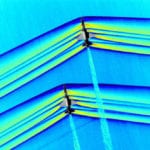 Our World
Our World  Our World
Our World  Pop Culture
Pop Culture 10 Incredible Female Comic Book Artists
 Crime
Crime 10 Terrifying Serial Killers from Centuries Ago
 Technology
Technology 10 Hilariously Over-Engineered Solutions to Simple Problems
 Miscellaneous
Miscellaneous 10 Ironic News Stories Straight out of an Alanis Morissette Song
 Politics
Politics 10 Lesser-Known Far-Right Groups of the 21st Century
 History
History Ten Revealing Facts about Daily Domestic Life in the Old West
 Weird Stuff
Weird Stuff 10 Everyday Products Surprisingly Made by Inmates
 Movies and TV
Movies and TV 10 Actors Dragged out of Retirement for One Key Role
 Creepy
Creepy 10 Lesser-Known Shapeshifter Legends from Around the World
 Our World
Our World 10 Science Facts That Will Change How You Look at the World
 Pop Culture
Pop Culture 10 Incredible Female Comic Book Artists
 Crime
Crime 10 Terrifying Serial Killers from Centuries Ago
Who's Behind Listverse?

Jamie Frater
Head Editor
Jamie founded Listverse due to an insatiable desire to share fascinating, obscure, and bizarre facts. He has been a guest speaker on numerous national radio and television stations and is a five time published author.
More About Us Technology
Technology 10 Hilariously Over-Engineered Solutions to Simple Problems
 Miscellaneous
Miscellaneous 10 Ironic News Stories Straight out of an Alanis Morissette Song
 Politics
Politics 10 Lesser-Known Far-Right Groups of the 21st Century
 History
History Ten Revealing Facts about Daily Domestic Life in the Old West
 Weird Stuff
Weird Stuff 10 Everyday Products Surprisingly Made by Inmates
 Movies and TV
Movies and TV 10 Actors Dragged out of Retirement for One Key Role
 Creepy
Creepy 10 Lesser-Known Shapeshifter Legends from Around the World
10 Historical First Images Captured Of Space
Neil Armstrong once said, “I think we’re going to the Moon because it’s in the nature of the human being to face challenges. It’s by the nature of his deep inner soul. We’re required to do these things just as salmon swim upstream.”
Just as powerful as our urge to face challenges, we humans also have the drive to record what we’ve seen. During our earlier ages of exploration, such as the Polynesian exploration of the Pacific or the age of European sailing ships, we recorded our discoveries through stories or the written word or paintings.
But the exploration of space has been unique. During our entire venture into the heavens, we have had access to photography. We can take living pictures for every new boundary broken and every new horizon. These are 10 such images, the first of their kind, taken in and about the infinite expanse of space.
10 The Very First Image Taken From Space
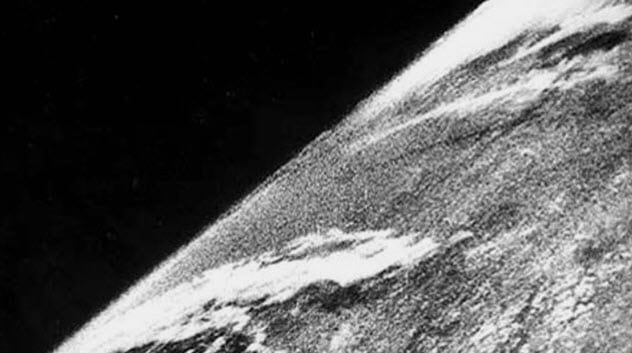
In October 1946, 15 years before humans visited space in person and less than a year after the conclusion of World War II, a team of scientists and soldiers in New Mexico launched a V-2 missile 105 kilometers (65 mi) into the sky. This rocket was equipped with a 35mm camera and snapped a photo every second and a half.
It achieved a height five times higher than the previous highest photo taken. When the V-2 missile’s photos were developed, what appeared on them affected the responsible team powerfully.
“They were ecstatic, they were jumping up and down like kids,” said Fred Rulli, an enlisted man involved in the camera recovery team. “The scientists just went nuts.”
And for good reason. The photos captured a sight that no human had ever seen before—Earth as viewed from beyond our atmosphere, Earth as seen from space. Many such missile launches were conducted in the coming years, and over 1,000 Earth pictures were recorded from space between 1946 and 1950.
But those pictures taken in 1946 would forever be our first view from outside our home.[1]
9 The First Image Taken Of The Sun
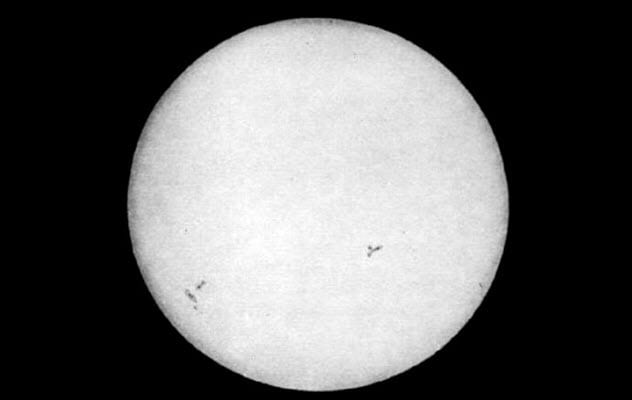
The Sun has been a constant companion for the entirety of human existence, but its very nature limited our understanding of it for much of history. The details of the Sun were often difficult to perceive because even looking at it was a strain. Features such as the corona and sunspots were usually painful to behold with the naked eye.
But in 1845 at the dawn of photography, two French physicists captured the first image of the Sun. Louis Fizeau and Lion Foucault recorded the image on a 12.7-centimeter (5 in) daguerreotype photograph. Though naked eye observations of sunspots date back to as early as 28 BC, this photo clearly depicted that day’s sunspots and allowed for a permanent record of the Sun’s cycles and changes.
In fact, by 1858, a daily record of the Sun was being kept by means of photography. Between 1858 and 1872, over 3,000 images of the Sun were captured and cataloged by Warren de la Rue at England’s Kew Observatory.[2]
Even a solar eclipse was captured by de la Rue’s team in Spain in 1860. Today, you can check on the Sun whenever you’d like via NASA’s Solar Dynamics Observatory, which posts nearly live images of the Sun captured through many different means and wavelengths.
8 The First Image Taken From The Surface Of Our Moon
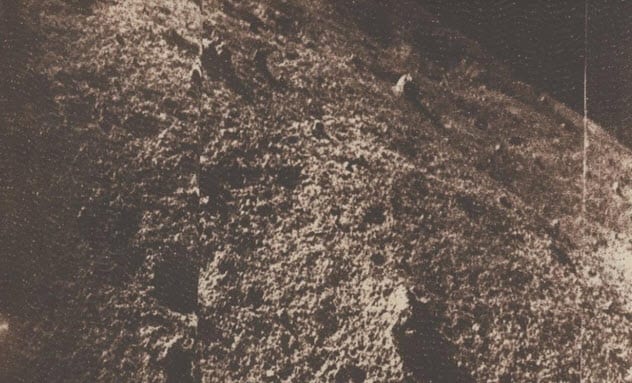
After a number of failed attempts, the Soviet Union succeeded in landing an unmanned spacecraft, Luna 9, on our Moon. The craft touched down on February 3, 1966, on an area of the Moon called Oceanus Procellarum (“Ocean of Storms”).
Luna 9 used airbags to cushion its rocky landing and was equipped with a turret camera that made history. This camera was the first of all time where a picture was taken on the surface of a celestial body besides Earth.
Luna 9 had limited power provided only through batteries, and it died three days after landing. But that was enough time to take and transmit a panorama from the Moon. The first image transmitted was intercepted and published in England even before the Soviet Union could publicize their success.[3]
7 First Image Of Auroras And Lightning On Another Planet

Two of the most brilliant and luminous phenomena on planet Earth were captured on a different celestial body for the first time during the historic flyby of Jupiter performed by the Voyager 1 spacecraft on March 5, 1979. The image—a grainy window of black and white—shows the curved horizon of our massive neighbor being lit by the planet’s own powerful auroras.
Caught in the same image, which was a three-minute-and-12-second exposure with a wide-angle lens, are the bright bursts of light from lightning churned into existence by Jupiter’s planetwide storms.[4]
The Voyager 1 flyby also found the first active volcanoes beyond Earth, the Jovian ring system, and two new moons of Jupiter. However, these images were only the beginning of its discovery.
Voyager 1 went on to visit Saturn and is the most far-flung man-made object. As of this writing, the craft is approximately 21.9 billion kilometers (13.6 billion mi) from our Sun.
6 First Image Of An Interstellar Visitor To Our Solar System
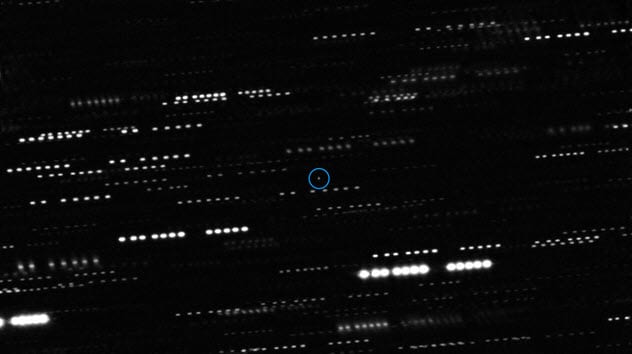
On October 19, 2017, an object (first called 1I/2017 U1) was detected by the Pan-STARRS1 telescope at the University of Hawaii, and this object defied definition. Originally, it was classified as a comet. But when no signs of comet-like activity (for example, no evidence of dust, ice, or water of any sort) were noted, it was reclassified as an asteroid.
However, that didn’t make sense, either. The object was measured to be accelerating as no asteroid would. On top of that, its brightness increased by a factor of 10 as it rotated. This was due to its shape, which was unlike anything ever seen in our solar system. It was long and cylindrical.
What was it?
Further observations determined that this object was not from our solar system. It was the first, and so far only, object confirmed to originate outside the domain of our Sun. A more fitting name was given to it—Oumuamua (pronounced “oh MOO-uh MOO-uh”)—a Hawaiian term meaning “a messenger from afar arriving first.”
Orbital calculations of Oumuamua suggest that it traveled to us by way of what is now the Vega star system. However, when Oumuamua was in that neck of the woods (300,000 years ago), Vega was not there. So its actual point of origin is still a mystery.
The image captured of Oumuamua shows only a tiny glimpse of this visitor. As it passed us, it traveled 315,000 kilometers per hour (196,000 mph), so the telescope capturing its image had to track its movement. This resulted in a picture of a small white dot surrounded by stars that were smeared by the movement of the telescope. An uninspiring picture of a very inspiring traveler.[5]
5 First Image Of A Comet Hitting A Planet
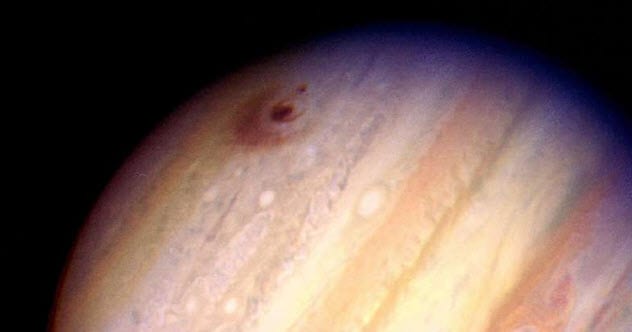
Shoemaker-Levy 9 was a comet discovered in March 1993 by Eugene and Carolyn Shoemaker and David Levy. This group of veteran trackers had discovered many other comets before this one, but this Shoemaker-Levy comet was something special.
After watching this fuzzy celestial body for some months, it became clear that this was the first comet discovered that did not revolve around our Sun. Instead, it orbited the planet Jupiter. Though it had likely been in orbit there for decades, we found it toward the end of its adventure. A little over a year later, Shoemaker-Levy 9 collided with the planet it orbited.
Between July 16 and July 22, 1994, Shoemaker-Levy 9 broke into 21 distinct fragments that slammed into the surface of Jupiter. At that time, the Galileo spacecraft was en route to Jupiter and too far away to observe the event. But astronomers the world over were watching.
Though the collisions occurred on the far side of Jupiter that was facing away from Earth, the impact site spun into view shortly thereafter. Astronomers were able to get a view of the impact site, sometimes mere minutes after the collisions.
Shoemaker-Levy 9 left massive dark smudges painted over the arch of Jupiter’s surface that lasted for at least a month before being consumed by the planet’s ever-turning storms.[6]
4 First Image Of An Exoplanet
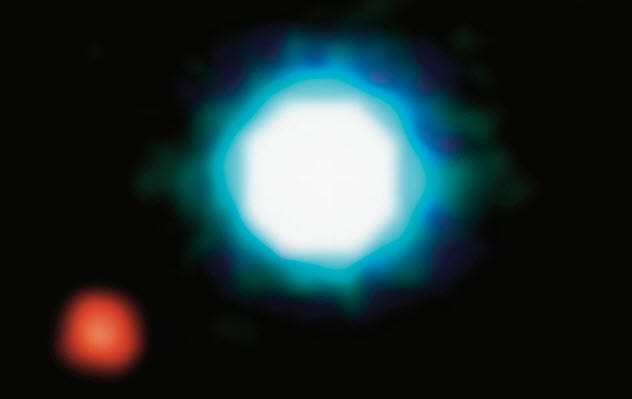
We’ve always known that there must be planets outside our own solar system. Unlike the massive and luminous stars they orbit, however, these exoplanets are small and dark by comparison. They are difficult to see, even with incredibly powerful telescopes. To view an exoplanet, we needed something even better.
Enter the accurately named Very Large Telescope (VLT) array which consists of four main 8.2-meter-diameter (26.9 ft) telescopes (named Antu, Kueyen, Melipal and Yepun) and four 1.8-meter-diameter (5.9 ft) auxiliary telescopes which could work independently of each other or in unison.
Independently, these mirrors can perceive light four billion times fainter than the naked human eye can. When the equipment works as a team, astronomers can see details 25 times greater than possible with each individual telescope.
Using this incredible piece of technology, the first image of an exoplanet was captured. The technology allowed this history-making photo, although the exoplanet was primed to be discovered because it was truly gigantic.
This exoplanet, which orbits a brown dwarf 230 light-years from us, is five times the size of Jupiter. Although other exoplanets have been found, this was the first one large enough to be directly imaged. As of this writing, over 4,000 exoplanets have been discovered.[7]
3 First Image Of An Unborn Exomoon
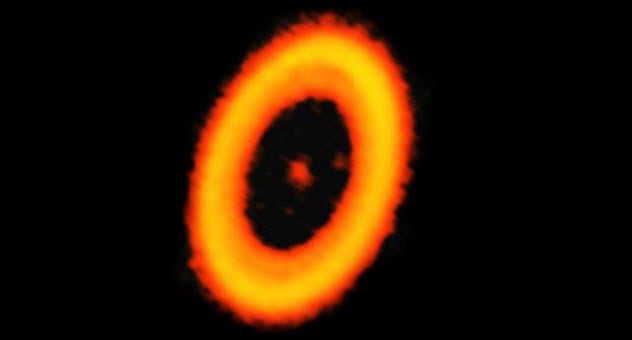
If exoplanets are difficult to find, you can imagine how difficult it is to see an exomoon. But an exomoon in the process of forming may be significantly easier. Using the Atacama Large Millimeter/submillimeter Array (ALMA), astronomers were able to capture an image of a ring of debris around a planet. This is known as a circumplanetary disk.
Unlike the rings around Saturn, which are icy and formed by comets, a circumplanetary disk is created in the same forge as the planet itself. Similar disks have been observed around stars. Called circumstellar disks, they give rise to planets.
This was the first such disk imaged around an exoplanet (or any planet for that matter as no circumstellar disks are in our own solar system). Given time, this disk will coalesce into one or more moons to accompany this new planet.[8]
2 First Image Of A Black Hole
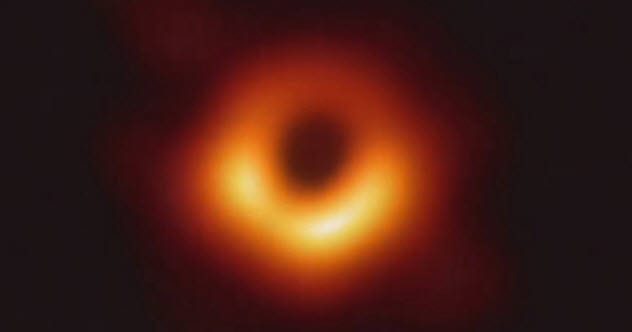
Black holes are celestial phenomena that have reached almost mythological status because of their mysterious nature and place in pop culture. These objects have so much mass and gravity that it becomes impossible for anything, including light, to escape from their unrelenting gravitational pull.
To capture an image of a black hole is impossible because no light, radio waves, or anything else can escape from its event horizon. So it is more accurate to say that this is the first image of a black hole’s silhouette—a shadow, as it were, of a black hole in contrast to the glowing hot material that it is consuming.
Capturing this image took a team of telescopes working simultaneously. Earlier, we discussed the VLT array and how its many telescopes worked in unison with each other. Capturing the image of a black hole’s silhouette took the same basic approach on a global basis.
A network of telescopes called the Event Horizon Telescope (EHT) was put to work. Many telescopes from across the planet were synchronized to look at a single object in space. The two most distant from each other were located in the South Pole and in Spain. The aperture of the EHT was almost the size of the Earth’s diameter.
In total, eight telescopes from around the world were used to capture this image of a supermassive black hole (6.5 billion times more massive than our own Sun) in the center of a galaxy 53 million light-years away.[9]
1 First Image Of A Survivor After A Supernova
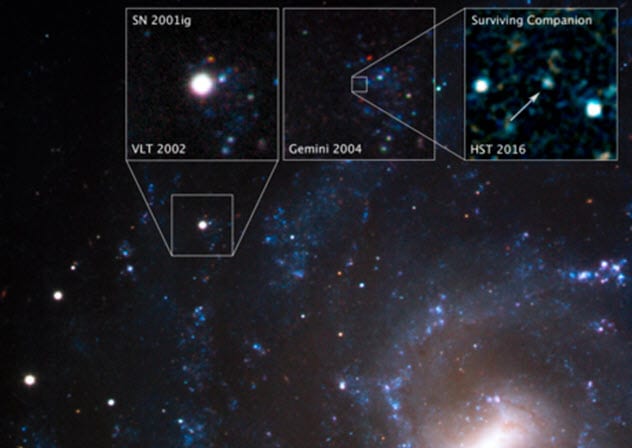
Supernovae are the most powerful explosions known to exist in space. They unleash such terrifying might that a supernova, even at a huge cosmological distance away from us, can still be so bright as to be distinctly visible during daylight.
Recorded in 1054, one such supernova was visible during the day for almost a month and visible at night for almost two years. Sometimes, these explosions happen at the end of a star’s life cycle. Particularly interesting is the Type IIb stripped-envelope supernova which happens when most of a star’s hydrogen is stripped away prior to exploding.
The cause of a Type IIb stripped-envelope supernova?
Many stars exist in pairs or triplets (unlike our Sun which is alone). In such a system, a star can begin eating away at the hydrogen of its partner. This was the case with supernova SN 2001ig, which exploded about 40 million light-years away (and 40 million years ago) in the galaxy NGC 7424.
Over the course of millions of years, a companion star robbed its partner of its outer sheath of hydrogen, which is used to channel energy from the core outward. Without this outer shell, the star became unstable and eventually exploded in a supernova, which scientists on Earth watched.
A decade after the explosion when the light from the blast dimmed, the Hubble Space Telescope was able to capture an image unlike any before it. The picture showed a survivor of a supernova that was also the thief star that had caused its partner to explode in the first place.[10]
For more incredible images of space, check out 10 Incredible Images of Space and 10 More Amazing Images Of Space Pareidolia.

